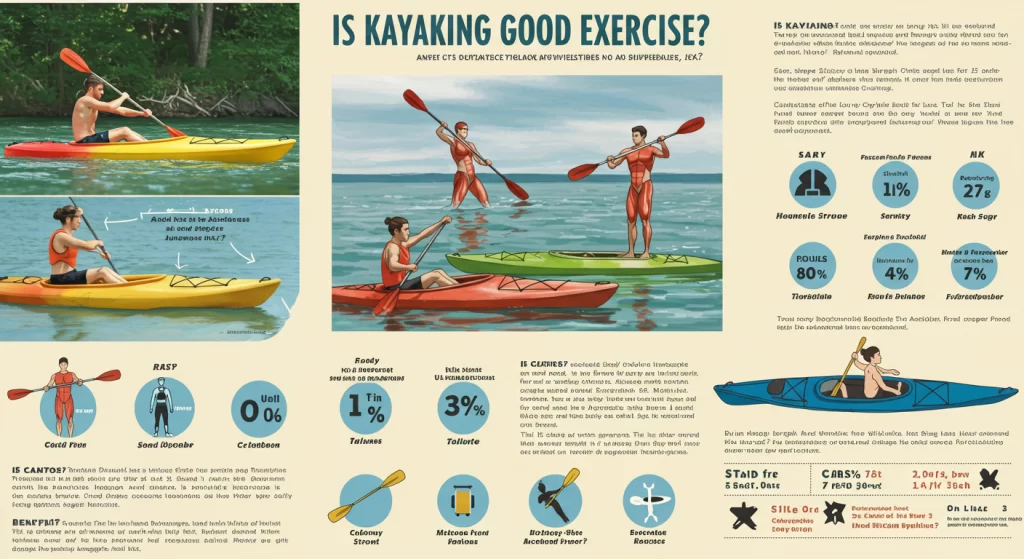
There’s something magical about gliding across a glassy lake or navigating a winding river—the sun on your face, the rhythm of your paddle dipping into the water, and the quiet hum of nature around you. But beyond the joy of being on the water, have you ever wondered if kayaking is good exercise? Spoiler alert: It’s not just a leisure activity. Kayaking is a powerhouse workout that strengthens your body, clears your mind, and fuels your sense of adventure. Let’s dive into why paddling might be the ultimate fitness hack you’ve been searching for.
The Physical Benefits of Kayaking as Exercise
Cardiovascular Health Boost
Kayaking isn’t just an arm workout—it’s a heart-pumping cardio session. Whether you’re cruising a calm inlet or tackling choppy waters, the continuous paddling motion elevates your heart rate, improving aerobic capacity and endurance. According to Better Health Victoria, regular kayaking can enhance cardiovascular fitness as effectively as cycling or brisk walking. The key? Consistency. A 30-minute session at moderate intensity can kickstart your heart health, while longer excursions amplify the benefits.
Full-Body Muscle Engagement
Forget the myth that kayaking only works your arms. Each stroke engages your core, shoulders, back, and even legs as you stabilize the kayak. The rotational motion of paddling activates your obliques and lats while your chest and triceps power the forward movement. As noted by Well+Good, this full-body engagement makes kayaking a stealthy strength-training workout.
Muscles Worked During Kayaking:
- Upper Body: Deltoids, triceps, biceps, pectorals
- Core: Obliques, rectus abdominis, lower back
- Lower Body: Quadriceps, hip flexors (for stability)
Calorie Torching on the Water
Want to burn calories without staring at a gym wall? Kayaking torches energy efficiently. A 170-pound paddler can burn 230–340 calories in 30 minutes, depending on intensity. Opt for whitewater kayaking or speed paddling, and you’ll incinerate over 1,000 calories in a 2-hour session (Virginia Beach County).
| Activity | Calories Burned (30 mins, 170 lbs) |
|---|---|
| Leisurely Kayaking | 230–280 |
| Moderate Paddling | 280–340 |
| Whitewater Kayaking | 340–400 |
Low-Impact, High Reward: Joint-Friendly Fitness
Unlike running or HIIT workouts, kayaking is gentle on joints. The seated, low-impact nature minimizes strain on knees and hips, making it ideal for older adults or those recovering from injuries. Research from Integris Health highlights kayaking’s role in improving flexibility and reducing arthritis discomfort through fluid, controlled movements.
Mental and Emotional Perks of Paddling
Stress Relief on Serene Waters
The therapeutic sound of water, paired with fresh air and sunlight, creates a natural stress-relief cocktail. A study cited by PMC found that outdoor activities like kayaking lower cortisol levels (the stress hormone) by up to 21%.
The Happiness Hormone Effect
Paddling triggers a flood of endorphins, serotonin, and dopamine—your body’s “feel-good” chemicals. These neurotransmitters combat anxiety, boost mood, and even alleviate symptoms of depression (Life and Ventures).
Building Confidence Through Challenges
Navigating rapids or mastering a self-rescue isn’t just about skill—it’s a confidence booster. Every challenge overcome on the water translates to mental resilience off the water.
Kayaking as Moving Meditation
The repetitive paddle strokes and focus required to balance create a meditative state. As Skyhook Adventure puts it, “Kayaking forces you to be present, quieting the mental chatter.”
Tailoring Kayaking to Your Fitness Journey
Adjusting Intensity for Maximum Gains
Kayaking adapts to your goals:
- Leisure Mode: Gentle paddling for recovery days.
- HIIT on Water: Sprint intervals (e.g., 1 minute fast, 2 minutes slow).
- Endurance Training: Long-distance paddles to build stamina.
Accessibility for All Ages and Abilities
From sit-on-top kayaks for beginners to adaptive models for wheelchair users, kayaking is inclusive. Organizations like Virginia Beach County offer guided tours for all skill levels.
Maximizing Your Kayaking Workout
Perfecting Your Paddle Technique
- Posture: Sit upright, feet braced against footpegs.
- Rotation: Twist your torso—not just your arms—to engage your core.
- Stroke Efficiency: Use a loose grip and push the water behind you.
Safety First: Protecting Your Body
- Warm up with dynamic stretches (arm circles, torso twists).
- Use a life jacket and sunscreen.
- Stay hydrated—dehydration saps performance.
Mixing Up Your Kayaking Routine
- Explore New Waters: Switch between lakes, rivers, and coastal routes.
- Try Kayak Fishing: Adds weight resistance when reeling in fish.
- Join a Club: Social paddles add motivation.
Real Stories: Kayakers Share Their Transformations
Sarah’s Journey: After a knee injury sidelined her from running, Sarah turned to kayaking. Within six months, she’d shed 15 pounds and regained strength. “It’s my therapy,” she says.
Mike’s Mental Shift: Battling burnout, Mike started dawn paddles. “The solitude helps me reset for the day,” he shares.
Kayaking vs. Other Cardio Workouts
| Aspect | Kayaking | Running | Cycling |
|---|---|---|---|
| Calories Burned | 230–400/30 mins | 300–450/30 mins | 250–350/30 mins |
| Joint Impact | Low | High | Moderate |
| Muscles Worked | Full-body | Lower body | Lower body |
| Mental Benefits | High (nature immersion) | Moderate | Moderate |
Conclusion: Dive Into a Healthier You
Kayaking isn’t just exercise—it’s an adventure that transforms your body and mind. From torching calories to building mental clarity, every paddle stroke brings you closer to a fitter, happier self.
Ready to Ride the Waves? Grab your paddle, explore local waterways, and join the community of kayakers who’ve found their fitness groove on the water. Share your story with #KayakFitness and inspire others to dive in!

